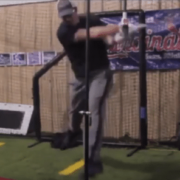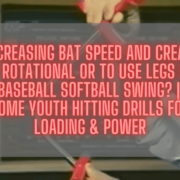Private Youth Hitting Lessons Fresno, CA: How To Use Lower Half Ground Reaction Forces, Baseball, & Softball Drills For Beginners
Discover private youth hitting lessons in Fresno, CA. Learn how to use lower half ground reaction forces, baseball, and softball drills for beginners…
How To Use Your Legs Like Edwin Encarnacion
I recently worked with Christopher Solis one-on-one, from Pasadena, CA. He just signed with the University of Sioux Falls, South Dakota this Fall to play for the Cougars division-two baseball team. He’s in his third year of eligibility, and found me after watching a video I did analyzing Lou Gehrig’s swing.
We talked about a lot of current hitters, but one in particular was Edwin Encarnacion. In this video, we’ll be discussing:
- What “Blocking” is (according to German Champion discus thrower Robert Harting),
- How Edwin Encarnacion “Blocks”, and
- Building Chris Solis 2.0.
SCIENCE-BASED TRAINING:
Improve your hitting strategy dramatically by applying human movement principles.
Learn not only how and what to train but also the science behind the methods.
What “Blocking” Is (According to German Champion Discus Thrower Robert Harding)
From what I’m told, the current German discus throwers “block” very well. Other throwers end up spinning around and hopping after they throw. What’s the significance of Blocking?
My friend Rob Suelflohn (top-5 national Shot Putter in mid-80’s) sent an email about a Facebook comment from former Shot Put world record holder Brian Oldfield, about Blocking:
“I have been looking back one of my experiences with Gideon Ariel at Casa de Cota and remembered throwing from a force plate that measured the P.S.I.’s [pounds per square inch] in my foot work/technique. I don’t know the exact pressure I put on each step of the transition but I think it went something like this. The first left foot pivot out of the back of the circle beginning the drive was 500 PSI’s then lunging down to the middle of the circle to the next right foot pivot created a 750 PSI pressure . Finally, a shorter deeper step at the toe board registered 1000 PSI’s. I used my speed and torque down through the “J” phase pushing on the earth until the earth pushed back.”
How Edwin Encarnacion “Blocks”
This home-run was Edwin Encarnacion’s 26th of the 2014 season, and a walk-off. Interesting to note, he was out in front of this 85-mph hanging breaker. And this is where “Blocking” becomes really important. Two things:
- The swing is a snapping towel – move forward to landing (Fight Position), then snap back (Blocking) through the turn, and
- Blocking is a combination of falling and pushing into the ground (Gravity), and the ground pushing back (Gravitational Reaction Forces).
“Sit back” hitters will have a difficult time with Blocking because they’re moving forward during the Final Turn. A hitter would have to be at least 6’3″ and 230-40 lbs to get away with sitting back.
Building Chris Solis 2.0
In our time together, we focused primarily on footwork. Getting to the proper Fight Position, then Blocking, or pushing into the ground as hard as we could to initiate the Final Turn. In the after video, we were able to:
- Get him “shorter” with his back leg through the turn (90 degrees versus a 104 degree angle),
- Detach, or un-weight, his back foot during his turn, and
- Shift his head/spine angle back (Blocking helps with this).
Blocking is how to fix the “racing back elbow” or “bat drag” so rampant in Little League. If you watch a racing back elbow hitter – not necessarily arm barring – you’ll see a bent front knee throughout the swing. Blocking with the front side is virtually non-existent, and their swing is inefficiently being driven by the backside. The racing back elbow is the back shoulder joint fighting to get into a stable position during the Final Turn.
We have to re-condition the front side to Block like Robert Harting and Edwin Encarnacion.
- Fix Late Swings Fast: 2025 Pitch Recognition & See-Decide-Swing Training for Youth Baseball Power Hitters - October 6, 2025
- Safe Youth Weighted Bat Training: Proven Overload/Underload Drills to Increase Exit Velocity in Games Starting Tonight - September 29, 2025
- AI Coaching Course 2025: Youth Baseball & Softball Practice Plan + Off-Season & In-Season Workout Builder Fast - September 23, 2025













This a great subject, and well covered as well. Perhaps the most over-looked, and misunderstood element of the swing is what happens with, and to the front leg. The heel is key in this part of the swing. Just try rotating through your full ROM with your front leg bent, and the ball, or front half of the front foot bearing the force and weight of the body. You can’t do it! Most instructors know from breaking down video that the front leg is straight at contact (99% of the time). But the reason it has to be straight is because you can’t rotate with it bent, and you can’t get it straight if you aren’t on that heel – or rolling over on the outside edge. But the last thing you want is your weight forward. Well done Joey.
Thanks Bob for posting this. I love how you urge people to experiment and try it for themselves. This is the best way – in what I’ve found – for my young hitters to “buy into” a hitting concept I’m trying to teach them. Bravo Bob! Thanks for your input.
Nice Job with Chris’s swing Joey. The changes you made will make a big difference for him once they become second nature.
Thanks Bob. As you know, the guidance we give is only half of the equation. It all depends on how much the hitter works on it outside of instruction. So I’m curious to see how Chris follows up with this 😉 I’ll keep you updated.
Been doing alot of research on the swing plane, hiding the hands, and inward (and down) shoulder turn. It seems that hitters that fight the bat handle from going forward the most have the most efficient swings. Hitters that fan or land with their front foot facing the pitcher more have a handle path that is more linear and flat towards the ball. Trout especially and Cabrera show their numbers much more than most and is a key to their early bat speed. They also block better. Trout has the most vertical path of the bat i have seen. The only other player with a similar steep path and steep shoulder plane (more like a golfers shoulder plane) is Clint Frazier in the minors. He swings like Trout and has ridiculous power for his size. The steeper shoulder plane is much much more condusive to power hitting. The trade off is being able to hit higher pitches.
Kyle, great finds! The one thing I’ve found with MLB camera angles is they’re bias to righties showing their numbers. Pitcher’s view camera angle is slightly off centered towards left field. But you’re absolutely right with Trout and Miggy. Cano does it real well from the left side of the plate, AND that’s with the off set camera angle! I did hear about Trout having the best vertical shoulder angle in the Bigs, which helps him get to low pitches so effectively. Addressing high versus low pitches has to do with more or less of a shoulder angle down towards the plate. I’m sure this is something that Trout can build into his swing so, that there’s not so much of a difference. At the same time, how often is the high strike called? Is it actually worth spending time on at his level?
Yep Joe…. I like to watch the finish of the swing… It tells u a lot. Trout, Miggy & Bonds have spent all there bat speed prior to impact so their follow throughs are shorter than the weaker hitters. They get the barrel in front of their chest very early in the swing with their back facing the pitcher more. This is the key to power to all fields. If the barrel never catches up to your belly button, than you are sliding the barrel into contact, not squaring the arc up. I watch the balls they hit to center field. If they cut a lot, they are slicing across. In the ideal swing they would go straight. But most hitter are still accelerating the handle not in proportion with the barrel.
You do great work and keep it up!!!!
Thanks Kyle. I totally agree with you. A Shot Put friend, Rob Suelflohn, sent me this video of Bonds hitting a home-run while breaking his bat: http://youtu.be/28Xs0sNh3ZM – Rob said, “…both (Barry Bonds & Randy Barnes – shot putter) were centered on doing the motion with the body not the act of pushing the shot away or swinging the bat around with the arms, but to CARRY the shot to the front or the bat to the follow thru…” I told him he’s on to something. I appreciate the kind words brotha…keep fighting the good fight 🙂
Yep… Good discussion! You’re on it bro!!
Joey…what do you think about the position of bat over the shoulder when the hitter starts to rotate? Please text me at 908-482-7566. I would like to do a few video lessons.
Kyle, I responded to your email about the online lessons. About your question on bat angle, more vertical than flat. Gravity takes over a flat barrel and makes the bat seem “end loaded”, which can cause arm barring or casting. Efficient small boppers (Cano, Bautista, McCutchen, etc) have their barrels around 40-55 degrees before the Final Turn. Even though completely vertical (or perpendicular to the ground) may be the lightest feel of the bat, it’s difficult to get the barrel on the pitch plane (aka an inclined plane) efficiently.